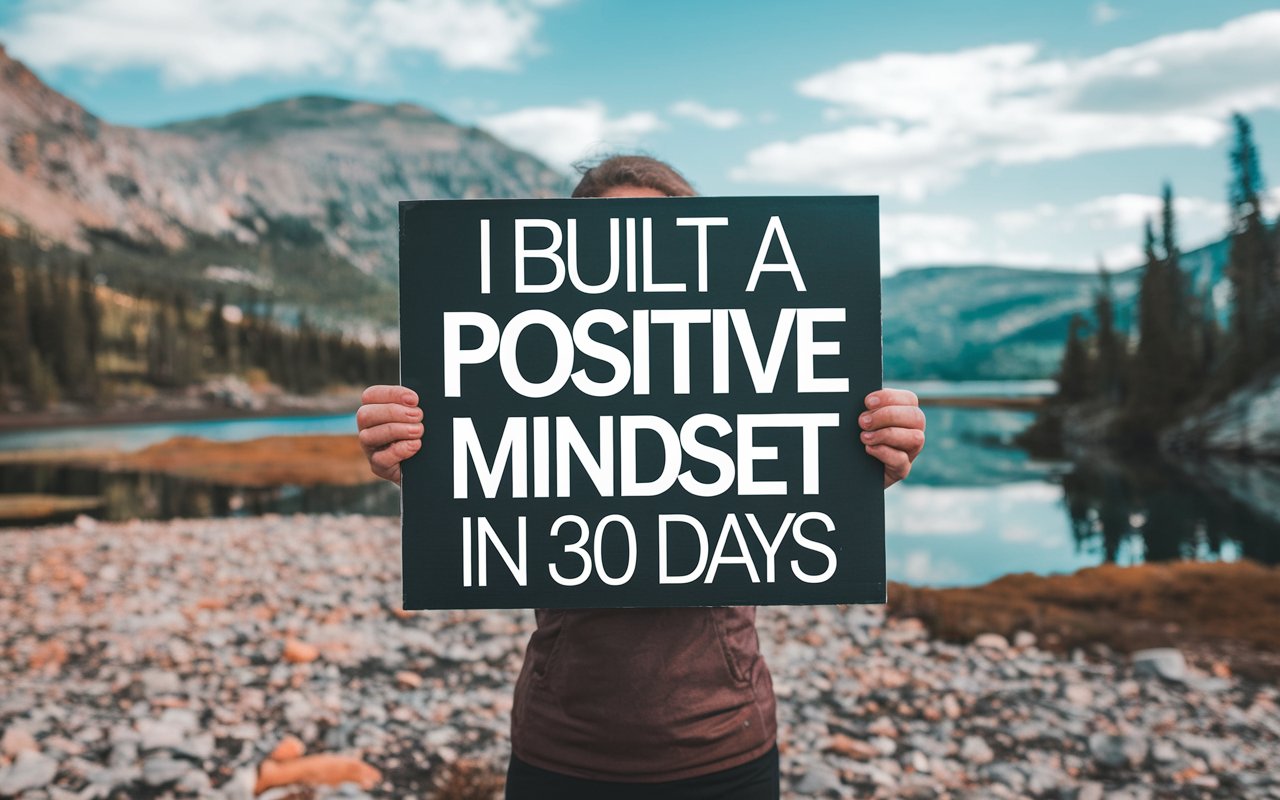A month ago, I felt stuck. My days felt heavy, and negativity clouded my thoughts. I realized something needed to change. I decided to challenge myself: build a positive mindset in just 30 days. At first, it seemed daunting, but I promised to take it one step at a time.
I started by identifying what made me feel unhappy and decided to focus on gratitude, mindfulness, and affirmations. These steps were simple but surprisingly effective.
By the end of this journey, I discovered the power of positive thinking. Here’s how it all unfolded and what I learned along the way.
Key Takeaways
- Positive thinking improves mental health.
- Small daily practices create lasting change.
- Gratitude, affirmations, and mindfulness are powerful tools.
- Surrounding yourself with positivity matters.

Understanding the Importance of a Positive Mindset
A positive mindset isn’t just about feeling good. It has profound effects on mental and physical health. Research shows it reduces stress, boosts resilience, and strengthens relationships.
When you focus on positivity, you’re more likely to see opportunities instead of obstacles. This mindset shift rewires the brain, making it easier to handle challenges. Positive thinking also influences physical health by reducing cortisol levels and improving heart health.
For me, understanding these benefits was the first step in committing to the 30-day journey. It gave me the motivation to start and stick with it.
Benefits of a Positive Mindset
| Benefit | Explanation |
| Reduced Stress | Lowers cortisol levels and increases calm. |
| Better Relationships | Encourages empathy and better communication. |
| Improved Mental Health | Reduces symptoms of anxiety and depression. |
| Increased Productivity | Promotes focus and problem-solving skills. |
Setting the Foundation: Preparing for the 30-Day Challenge
Preparation is key to success. Before starting, I set clear goals and created a plan. Here’s what I did:
- Defined my why: I wanted to feel lighter and happier.
- Wrote my goals: Practice gratitude, think positively, and stay mindful.
- Eliminated distractions: Reduced time spent on negative media.
- Found support: Told a friend about my challenge.
This foundation helped me stay focused. Writing down my goals made them feel tangible, and sharing them with a friend kept me accountable.
I also prepared by organizing my space and creating a morning routine that included journaling and affirmations. These small changes set the stage for a successful month.

Week 1: Embracing Daily Gratitude Practices
I started small. Each morning, I wrote down three things I was grateful for. Some days, it was as simple as a sunny morning or a good cup of coffee.
Other days, I reflected on deeper moments, like a meaningful conversation or overcoming a challenge. Gratitude shifted my focus from what I lacked to what I already had. This simple habit changed my perspective and lifted my mood.
Quick Tips for Practicing Gratitude:
- Keep a gratitude journal.
- Say “thank you” more often.
- Reflect on positive moments before bed.
Research Insight
Studies show gratitude improves mood and strengthens the immune system. It’s a simple yet powerful practice. By the end of week one, I noticed I was starting my days with more energy and positivity.

Week 2: Techniques to Stay Optimistic Amid Challenges
Life throws challenges, but staying optimistic is a choice. This week, I practiced reframing negative thoughts. When something went wrong, I asked, “What can I learn from this?” For example, when I missed an appointment, instead of beating myself up, I focused on improving my time management.
Step-by-Step Guide:
- Identify the negative thought.
- Acknowledge it without judgment.
- Replace it with a positive alternative.
This practice wasn’t always easy, but it was worth it. Over time, I noticed fewer negative thoughts and a calmer response to setbacks.
“Optimism is the faith that leads to achievement.” – Helen Keller

Week 3: Building Positive Thinking Habits
Positive thinking requires consistent effort. This week, I focused on:
- Morning affirmations: Saying phrases like, “I am capable.”
- Daily reflections: Writing one positive experience each day.
- Avoiding negativity: Skipping gossip and negative news.
These habits became part of my routine. Affirmations boosted my confidence, while reflections helped me see the good in every day.
Avoiding negativity made space for more uplifting experiences. Together, these habits strengthened my positive mindset.
Habit Tracker Example
| Day | Positive Habit Practiced |
| Monday | Morning affirmation |
| Tuesday | Wrote a positive reflection |
| Wednesday | Avoided negative conversations |

Week 4: Integrating Positive Affirmations into Daily Life
This week, I embraced affirmations fully. I repeated them while brushing my teeth, during my commute, and before sleeping. It felt strange at first, but soon, I believed my words. These affirmations became a source of strength, especially during stressful moments.
Examples of Positive Affirmations:
- “I am enough.”
- “I attract good energy.”
- “I handle challenges with grace.”
By the end of the week, affirmations felt natural. They reminded me of my progress and kept me focused on my goals.
Overcoming Obstacles: Dealing with Setbacks During the Journey
There were tough days. Sometimes, I felt discouraged or forgot my practices. Instead of giving up, I reminded myself it’s okay to slip. Progress isn’t always linear.
Tips for Handling Setbacks:
- Be kind to yourself.
- Revisit your goals.
- Start fresh the next day.
Reflecting on setbacks taught me resilience. Each obstacle was an opportunity to learn and grow.
Measuring Progress: Reflecting on the 30-Day Transformation
At the end of 30 days, I felt lighter, calmer, and more optimistic. Reflecting on my journey, I noticed:
- Increased gratitude: I appreciated small moments more.
- Improved resilience: Challenges felt less overwhelming.
- Positive habits: Gratitude and affirmations became second nature.
Writing about my progress helped me see how far I’d come. It motivated me to keep going and sustain the positive changes I’d made.
Sustaining a Positive Mindset Beyond 30 Days
Building a positive mindset is a lifelong journey. To maintain it, I committed to continuing daily gratitude, affirmations, and mindfulness practices. I also set monthly mindset goals to stay on track.
Long-Term Tips:
- Set monthly mindset goals.
- Surround yourself with positive influences.
- Keep learning about positivity.
These strategies ensure that the habits I built during the challenge become a permanent part of my life.
The Science Behind Positive Thinking
Positive thinking isn’t just feel-good advice; it’s backed by science. Studies show it improves brain function and enhances problem-solving skills. Positive thinkers are also more likely to live longer, healthier lives.
Researchers explain that focusing on positive thoughts rewires the brain, creating new neural pathways. This makes it easier to stay optimistic, even during tough times. Understanding the science gave me confidence in my efforts and inspired me to keep going.
Daily Journaling for Mindset Shifts
Journaling helped me process my thoughts and focus on the good. Each day, I wrote about:
- One thing I’m grateful for.
- A positive experience that day.
- A challenge I overcame.
This simple practice kept me grounded and aware of my progress. Journaling also served as a tool for reflection and growth.
Example Journal Entry
| Date | Gratitude | Positive Experience | Challenge Overcome |
| October 1 | Sunny weather | Helped a friend | Stayed calm during traffic |
Mindfulness Practices to Enhance Positivity
Mindfulness kept me present. I practiced deep breathing, meditation, and mindful walking. These practices calmed my mind and reduced stress.
Simple Breathing Exercise:
- Inhale for 4 counts.
- Hold for 4 counts.
- Exhale for 4 counts.
- Repeat 4 times.
Mindfulness became a daily anchor, helping me navigate stress and focus on the present moment.
Creating a Vision Board for Motivation
I made a vision board to stay inspired. It included images and words representing my goals and dreams. Seeing it daily reminded me of what I was working toward.
How to Create One:
- Collect magazines or print images.
- Cut out pictures that inspire you.
- Arrange them on a board.
- Place it somewhere visible.
This creative process was both fun and motivating. It reinforced my commitment to positivity.
The Power of Surrounding Yourself with Positivity
The people you surround yourself with impact your mindset. I spent more time with supportive friends and limited interactions with negative influences.
Positive Surroundings Checklist:
- Supportive friends and family.
- Uplifting books or podcasts.
- Clean, organized spaces.
Creating a positive environment made it easier to maintain my mindset. It reminded me that positivity is contagious.
Using Challenges as Growth Opportunities
Challenges are inevitable, but they’re also opportunities to grow. I learned to view setbacks as lessons instead of failures.
Quick Tips:
- Focus on the solution, not the problem.
- Celebrate small improvements.
- Remind yourself: growth takes time.
By shifting my perspective, I turned challenges into stepping stones for success.
Celebrating Small Wins to Build Momentum
Acknowledging small wins was a game-changer for me. Instead of waiting for a major breakthrough, I celebrated small steps forward. These moments reminded me that progress doesn’t have to be huge to matter.
For example, completing my morning affirmations or staying calm during a stressful situation felt like achievements. Each small win fueled my motivation to keep going.
Why Small Wins Matter:
- They boost confidence.
- They create a sense of accomplishment.
- They make larger goals feel attainable.
How I Celebrated Small Wins:
- Treating myself to a favorite snack.
- Sharing my progress with a friend.
- Taking a moment to reflect and smile.
These little celebrations kept me excited about the journey. They helped me see value in consistency and reassured me that even the smallest effort made a difference. By recognizing these wins, I stayed motivated to push through the entire 30 days.
Mindfulness Practices to Enhance Positivity
Mindfulness played a crucial role in my 30-day journey. It helped me focus on the present instead of dwelling on the past or worrying about the future. I started with five-minute breathing exercises each morning. Gradually, I incorporated mindful eating and short meditation sessions into my day.
Easy Mindfulness Practices:
- Breathing exercises: Focus on slow, deep breaths.
- Mindful walks: Notice sights and sounds around you.
- Body scans: Pay attention to physical sensations.
Research confirms that mindfulness reduces stress and improves emotional well-being. Practicing mindfulness consistently helped me feel calmer and more aware of the positives in my life.
Creating a Vision Board for Motivation
A vision board became my source of inspiration. I collected pictures, quotes, and words that reflected my goals and dreams. Placing the board in my workspace kept me motivated throughout the day.
Steps to Create a Vision Board:
- Gather materials (poster board, magazines, scissors).
- Choose images and words that inspire you.
- Arrange them on your board.
- Display it where you’ll see it often.
Seeing my vision board daily reminded me of my “why” and kept me focused. It also reinforced the belief that I could achieve my goals.
The Power of Surrounding Yourself with Positivity
The people and environments you engage with shape your mindset. I chose to spend more time with supportive friends and avoided negative influences. I also filled my space with uplifting books, music, and decor.
Quick Tips:
- Follow inspiring accounts on social media.
- Spend time with optimistic people.
- Declutter your space to reduce stress.
Positive surroundings elevated my mood and reinforced my efforts to stay optimistic. This shift made a huge difference in my journey.

Using Challenges as Growth Opportunities
Instead of fearing challenges, I learned to see them as opportunities for growth. Each setback taught me valuable lessons and strengthened my resilience. For example, when I struggled with procrastination, I worked on creating a better schedule.
How to Turn Challenges Into Opportunities:
- Pause: Take a moment to reflect.
- Identify: Find the lesson in the challenge.
- Act: Use the lesson to improve.
Challenges are unavoidable, but how we approach them matters. This mindset shift made me more confident in handling obstacles.
Celebrating Small Wins to Build Momentum
Celebrating small victories kept me motivated during my 30-day challenge. Whether it was completing a journal entry or sticking to my affirmations, I acknowledged my efforts and progress.
Ideas for Celebrating Wins:
- Treat yourself to a favorite snack.
- Share your achievement with a friend.
- Write about the win in your journal.
Small celebrations create positive reinforcement, making it easier to stay on track. These moments of joy added up, boosting my confidence and energy.
Healthy Lifestyle Habits for Mental Positivity
Physical health impacts mental positivity. I incorporated healthy habits like regular exercise, balanced meals, and good sleep into my routine. Even simple changes, like drinking more water, made a noticeable difference.
Healthy Habits to Adopt:
- Exercise for 20 minutes daily.
- Eat whole foods like fruits and vegetables.
- Stick to a consistent sleep schedule.
Feeling physically better supported my positive mindset. It reminded me that small steps lead to significant changes.
Detoxing from Negative Media and Environments
Reducing exposure to negativity was essential for my mental well-being. I limited my time on social media, avoided sensational news, and distanced myself from toxic relationships.
Steps to Detox:
- Unfollow negative accounts.
- Set screen time limits.
- Spend time in calming environments.
This detox created space for positivity. It made me more mindful of what I consumed and how it affected my mood.
The Role of Acts of Kindness in Boosting Optimism
Acts of kindness had a ripple effect on my mindset. Simple gestures, like helping a neighbor or complimenting someone, made me feel connected and fulfilled. These small actions reinforced the idea that positivity spreads.
Examples of Acts of Kindness:
- Hold the door open for someone.
- Donate to a cause you care about.
- Write a thank-you note.
Kindness fosters a sense of purpose and strengthens bonds. It reminded me that we all have the power to make a difference.

FAQs About Build Positive Mindset
Final Thoughts
Building a positive mindset in 30 days wasn’t easy, but it was transformative. Each step brought me closer to feeling happier and more fulfilled. Remember, progress takes time. Celebrate small wins, learn from challenges, and keep going. Your mindset shapes your life—choose to make it a positive one!




